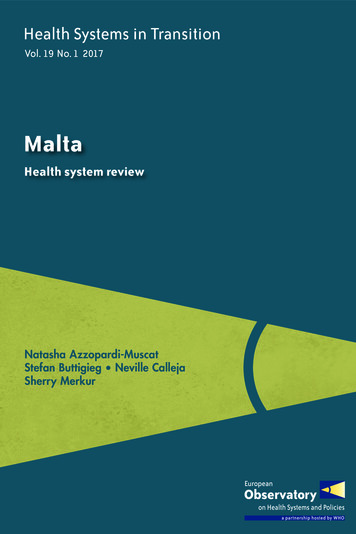
Transcription
Health Systems in TransitionVol. 19 No. 1 2017MaltaHealth system reviewNatasha Azzopardi-MuscatStefan Buttigieg Neville CallejaSherry Merkur
Sherry Merkur (editor) and Ellen Nolte and Ewout van Ginneken (Series editors)were responsible for this HiTEditorial BoardSeries editorsReinhard Busse, Berlin University of Technology, GermanyJosep Figueras, European Observatory on Health Systems and PoliciesMartin McKee, London School of Hygiene & Tropical Medicine, United KingdomElias Mossialos, London School of Economics and Political Science, United KingdomEllen Nolte, European Observatory on Health Systems and PoliciesEwout van Ginneken, Berlin University of Technology, GermanySeries coordinatorGabriele Pastorino, European Observatory on Health Systems and PoliciesEditorial teamJonathan Cylus, European Observatory on Health Systems and PoliciesCristina Hernández-Quevedo, European Observatory on Health Systems and PoliciesMarina Karanikolos, European Observatory on Health Systems and PoliciesAnna Maresso, European Observatory on Health Systems and PoliciesDavid McDaid, European Observatory on Health Systems and PoliciesSherry Merkur, European Observatory on Health Systems and PoliciesDimitra Panteli, Berlin University of Technology, GermanyWilm Quentin, Berlin University of Technology, GermanyBernd Rechel, European Observatory on Health Systems and PoliciesErica Richardson, European Observatory on Health Systems and PoliciesAnna Sagan, European Observatory on Health Systems and PoliciesAnne Spranger, Berlin University of Technology, GermanyInternational advisory boardTit Albreht, Institute of Public Health, SloveniaCarlos Alvarez-Dardet Díaz, University of Alicante, SpainRifat Atun, Harvard University, United StatesArmin Fidler, Management Center InnsbruckColleen Flood, University of Toronto, CanadaPéter Gaál, Semmelweis University, HungaryUnto Häkkinen, National Institute for Health and Welfare, FinlandWilliam Hsiao, Harvard University, United StatesAllan Krasnik, University of Copenhagen, DenmarkJoseph Kutzin, World Health OrganizationSoonman Kwon, Seoul National University, Republic of KoreaJohn Lavis, McMaster University, CanadaVivien Lin, La Trobe University, AustraliaGreg Marchildon, University of Regina, CanadaAlan Maynard, University of York, United KingdomNata Menabde, World Health OrganizationCharles Normand, University of Dublin, IrelandRobin Osborn, The Commonwealth Fund, United StatesDominique Polton, National Health Insurance Fund for Salaried Staff (CNAMTS), FranceSophia Schlette, Federal Statutory Health Insurance Physicians Association, GermanyIgor Sheiman, Higher School of Economics, Russian FederationPeter C. Smith, Imperial College, United KingdomWynand P.M.M. van de Ven, Erasmus University, The NetherlandsWitold Zatonski, Marie Sklodowska-Curie Memorial Cancer Centre, Poland
Health Systemsin TransitionNatasha Azzopardi-Muscat, Department of Health Services Management,Faculty of Health Science, University of Malta; Directorate for HealthInformation and Research, Ministry for Health, MaltaStefan Buttigieg, Directorate for Health Information and Research,Ministry for Health, MaltaNeville Calleja, Directorate for Health Information and Research,Ministry for Health, MaltaSherry Merkur, European Observatory on Health Systems and PoliciesMalta:Health System Review2017The European Observatory on Health Systems and Policies is a partnership between theWHO Regional Office for Europe, the Governments of Austria, Belgium, Finland, Ireland,Norway, Slovenia, Sweden, Switzerland, the United Kingdom and the Veneto Region of Italy,the European Commission, the World Bank, UNCAM (French National Union of Health InsuranceFunds), the London School of Economics and Political Science, and the London School ofHygiene & Tropical Medicine. The European Observatory has a secretariat in Brussels andit has hubs in London (at LSE and LSHTM) and at the Technical University in Berlin.
Keywords:DELIVERY OF HEALTH CAREEVALUATION STUDIESFINANCING, HEALTHHEALTH CARE REFORMHEALTH SYSTEM PLANS – organization and administrationMALTA World Health Organization 2017 (acting as the hostorganization for, and secretariat of, the EuropeanObservatory on Health Systems and Policies).All rights reserved. The European Observatory onHealth Systems and Policies welcomes requests forpermission to reproduce or translate its publications,in part or in full.Please address requests about the publication to:Publications,WHO Regional Office for Europe,UN City,Marmorvej 51,DK-2100 Copenhagen Ø, DenmarkAlternatively, complete an online request form fordocumentation, health information, or for permissionto quote or translate, on the Regional Office web site(http://www.euro.who.int/pubrequest)The views expressed by authors or editors do notnecessarily represent the decisions or the stated policiesof the European Observatory on Health Systems andPolicies or any of its partners.The designations employed and the presentation of thematerial in this publication do not imply the expressionof any opinion whatsoever on the part of the EuropeanObservatory on Health Systems and Policies or any ofits partners concerning the legal status of any country,territory, city or area or of its authorities, or concerningthe delimitation of its frontiers or boundaries. Where thedesignation “country or area” appears in the headings oftables, it covers countries, territories, cities, or areas.Dotted lines on maps represent approximate border linesfor which there may not yet be full agreement.The mention of specific companies or of certainmanufacturers’ products does not imply that they areendorsed or recommended by the European Observatoryon Health Systems and Policies in preference to othersof a similar nature that are not mentioned. Errors andomissions excepted, the names of proprietary productsare distinguished by initial capital letters.The European Observatory on Health Systems and Policiesdoes not warrant that the information contained in thispublication is complete and correct and shall not be liablefor any damages incurred as a result of its use.Printed and bound in the United Kingdom.Suggested citation:Azzopardi-Muscat N, Buttigieg S, Calleja N, Merkur S (2017). Malta: Healthsystem review. Health Systems in Transition, 2017; 19(1):1–137.HiTs and HiT summaries are available on the Observatory’s website(http://www.healthobservatory.eu)ISSN 1817-6127 Vol. 19 No. 1
ContentsContentsPreface . . . . . . . . . . . . . . . . . . . . . . . . . . . . . . . . . . . . . . . . . . . . . . . . . . . . . . . . . . . . . . . . . . . . . . . . . . . . . . . . . . . . . . . . . . . . . . . . . . . . . . . . . vAcknowledgements . . . . . . . . . . . . . . . . . . . . . . . . . . . . . . . . . . . . . . . . . . . . . . . . . . . . . . . . . . . . . . . . . . . . . . . . . . . . . . . . . . . . viiList of abbreviations . . . . . . . . . . . . . . . . . . . . . . . . . . . . . . . . . . . . . . . . . . . . . . . . . . . . . . . . . . . . . . . . . . . . . . . . . . . . . . . . . . . ixList of tables, figures and boxes . . . . . . . . . . . . . . . . . . . . . . . . . . . . . . . . . . . . . . . . . . . . . . . . . . . . . . . . . . . . . . . . . xiAbstract . . . . . . . . . . . . . . . . . . . . . . . . . . . . . . . . . . . . . . . . . . . . . . . . . . . . . . . . . . . . . . . . . . . . . . . . . . . . . . . . . . . . . . . . . . . . . . . . . . . . xiiiExecutive summary . . . . . . . . . . . . . . . . . . . . . . . . . . . . . . . . . . . . . . . . . . . . . . . . . . . . . . . . . . . . . . . . . . . . . . . . . . . . . . . . . . . xv1. Introduction . . . . . . . . . . . . . . . . . . . . . . . . . . . . . . . . . . . . . . . . . . . . . . . . . . . . . . . . . . . . . . . . . . . . . . . . . . . . . . . . . . . . . . . . . . . . . 11.1 Geography and sociodemography . . . . . . . . . . . . . . . . . . . . . . . . . . . . . . . . . . . . . . . . . . . . . . . . . . . . . . . . . . . . . . . 11.2 Economic context. . . . . . . . . . . . . . . . . . . . . . . . . . . . . . . . . . . . . . . . . . . . . . . . . . . . . . . . . . . . . . . . . . . . . . . . . . . . . . . . . . . . . . 41.3 Political context . . . . . . . . . . . . . . . . . . . . . . . . . . . . . . . . . . . . . . . . . . . . . . . . . . . . . . . . . . . . . . . . . . . . . . . . . . . . . . . . . . . . . . . . 51.4 Health status . . . . . . . . . . . . . . . . . . . . . . . . . . . . . . . . . . . . . . . . . . . . . . . . . . . . . . . . . . . . . . . . . . . . . . . . . . . . . . . . . . . . . . . . . . . . . 62. Organization and governance . . . . . . . . . . . . . . . . . . . . . . . . . . . . . . . . . . . . . . . . . . . . . . . . . . . . . . . . . . . . . . .2.1 Organization . . . . . . . . . . . . . . . . . . . . . . . . . . . . . . . . . . . . . . . . . . . . . . . . . . . . . . . . . . . . . . . . . . . . . . . . . . . . . . . . . . . . . . . . . . .2.2 Decentralization and centralization . . . . . . . . . . . . . . . . . . . . . . . . . . . . . . . . . . . . . . . . . . . . . . . . . . . . . . . . . .2.3 Intersectorality . . . . . . . . . . . . . . . . . . . . . . . . . . . . . . . . . . . . . . . . . . . . . . . . . . . . . . . . . . . . . . . . . . . . . . . . . . . . . . . . . . . . . . .2.4 Regulation and planning . . . . . . . . . . . . . . . . . . . . . . . . . . . . . . . . . . . . . . . . . . . . . . . . . . . . . . . . . . . . . . . . . . . . . . . . . .2.5 Patient empowerment . . . . . . . . . . . . . . . . . . . . . . . . . . . . . . . . . . . . . . . . . . . . . . . . . . . . . . . . . . . . . . . . . . . . . . . . . . . . . .1112171818243. Financing . . . . . . . . . . . . . . . . . . . . . . . . . . . . . . . . . . . . . . . . . . . . . . . . . . . . . . . . . . . . . . . . . . . . . . . . . . . . . . . . . . . . . . . . . . . . . . .3.1 Health expenditure . . . . . . . . . . . . . . . . . . . . . . . . . . . . . . . . . . . . . . . . . . . . . . . . . . . . . . . . . . . . . . . . . . . . . . . . . . . . . . . . . .3.2 Sources of revenue and financial flows. . . . . . . . . . . . . . . . . . . . . . . . . . . . . . . . . . . . . . . . . . . . . . . . . . . . .3.3 Overview of the statutory financing system . . . . . . . . . . . . . . . . . . . . . . . . . . . . . . . . . . . . . . . . . . . . . .3.4 Out-of-pocket payments . . . . . . . . . . . . . . . . . . . . . . . . . . . . . . . . . . . . . . . . . . . . . . . . . . . . . . . . . . . . . . . . . . . . . . . . . .3.5 Voluntary health insurance (VHI) . . . . . . . . . . . . . . . . . . . . . . . . . . . . . . . . . . . . . . . . . . . . . . . . . . . . . . . . . . . .3.6 Other financing. . . . . . . . . . . . . . . . . . . . . . . . . . . . . . . . . . . . . . . . . . . . . . . . . . . . . . . . . . . . . . . . . . . . . . . . . . . . . . . . . . . . . . .3.7 Payment mechanisms . . . . . . . . . . . . . . . . . . . . . . . . . . . . . . . . . . . . . . . . . . . . . . . . . . . . . . . . . . . . . . . . . . . . . . . . . . . . . .3132374146474850
ivHealth systems in transitionMalta4. Physical and human resources . . . . . . . . . . . . . . . . . . . . . . . . . . . . . . . . . . . . . . . . . . . . . . . . . . . . . . . . . . . . . . 534.1 Physical resources . . . . . . . . . . . . . . . . . . . . . . . . . . . . . . . . . . . . . . . . . . . . . . . . . . . . . . . . . . . . . . . . . . . . . . . . . . . . . . . . . . . 544.2 Human resources . . . . . . . . . . . . . . . . . . . . . . . . . . . . . . . . . . . . . . . . . . . . . . . . . . . . . . . . . . . . . . . . . . . . . . . . . . . . . . . . . . . . 595. Provision of services . . . . . . . . . . . . . . . . . . . . . . . . . . . . . . . . . . . . . . . . . . . . . . . . . . . . . . . . . . . . . . . . . . . . . . . . . . . . . .5.1 Public health . . . . . . . . . . . . . . . . . . . . . . . . . . . . . . . . . . . . . . . . . . . . . . . . . . . . . . . . . . . . . . . . . . . . . . . . . . . . . . . . . . . . . . . . . . .5.2 Patient pathways . . . . . . . . . . . . . . . . . . . . . . . . . . . . . . . . . . . . . . . . . . . . . . . . . . . . . . . . . . . . . . . . . . . . . . . . . . . . . . . . . . . . .5.3 Primary/ambulatory care . . . . . . . . . . . . . . . . . . . . . . . . . . . . . . . . . . . . . . . . . . . . . . . . . . . . . . . . . . . . . . . . . . . . . . . . .5.4 Specialized ambulatory care/inpatient care . . . . . . . . . . . . . . . . . . . . . . . . . . . . . . . . . . . . . . . . . . . . . . .5.5 Emergency care . . . . . . . . . . . . . . . . . . . . . . . . . . . . . . . . . . . . . . . . . . . . . . . . . . . . . . . . . . . . . . . . . . . . . . . . . . . . . . . . . . . . . .5.6 Pharmaceutical care . . . . . . . . . . . . . . . . . . . . . . . . . . . . . . . . . . . . . . . . . . . . . . . . . . . . . . . . . . . . . . . . . . . . . . . . . . . . . . . .5.7 Rehabilitation/intermediate care . . . . . . . . . . . . . . . . . . . . . . . . . . . . . . . . . . . . . . . . . . . . . . . . . . . . . . . . . . . . . . .5.8 Long-term care . . . . . . . . . . . . . . . . . . . . . . . . . . . . . . . . . . . . . . . . . . . . . . . . . . . . . . . . . . . . . . . . . . . . . . . . . . . . . . . . . . . . . . .5.9 Services for informal carers . . . . . . . . . . . . . . . . . . . . . . . . . . . . . . . . . . . . . . . . . . . . . . . . . . . . . . . . . . . . . . . . . . . . .5.10 Palliative care . . . . . . . . . . . . . . . . . . . . . . . . . . . . . . . . . . . . . . . . . . . . . . . . . . . . . . . . . . . . . . . . . . . . . . . . . . . . . . . . . . . . . . . .5.11 Mental health care . . . . . . . . . . . . . . . . . . . . . . . . . . . . . . . . . . . . . . . . . . . . . . . . . . . . . . . . . . . . . . . . . . . . . . . . . . . . . . . . .5.12 Dental care . . . . . . . . . . . . . . . . . . . . . . . . . . . . . . . . . . . . . . . . . . . . . . . . . . . . . . . . . . . . . . . . . . . . . . . . . . . . . . . . . . . . . . . . . . . .696971747780828485868687886. Principal health reforms . . . . . . . . . . . . . . . . . . . . . . . . . . . . . . . . . . . . . . . . . . . . . . . . . . . . . . . . . . . . . . . . . . . . . . . 896.1 Analysis of recent reforms . . . . . . . . . . . . . . . . . . . . . . . . . . . . . . . . . . . . . . . . . . . . . . . . . . . . . . . . . . . . . . . . . . . . . . . 906.2 Future developments . . . . . . . . . . . . . . . . . . . . . . . . . . . . . . . . . . . . . . . . . . . . . . . . . . . . . . . . . . . . . . . . . . . . . . . . . . . . . . 1007. Assessment of the health system . . . . . . . . . . . . . . . . . . . . . . . . . . . . . . . . . . . . . . . . . . . . . . . . . . . . . . . . . . . 1037.1 Monitoring health system performance . . . . . . . . . . . . . . . . . . . . . . . . . . . . . . . . . . . . . . . . . . . . . . . . . . . . 1047.2 Health system impact on population health . . . . . . . . . . . . . . . . . . . . . . . . . . . . . . . . . . . . . . . . . . . . . . 1097.3 Access . . . . . . . . . . . . . . . . . . . . . . . . . . . . . . . . . . . . . . . . . . . . . . . . . . . . . . . . . . . . . . . . . . . . . . . . . . . . . . . . . . . . . . . . . . . . . . . . . . . 1137.4 Financial protection . . . . . . . . . . . . . . . . . . . . . . . . . . . . . . . . . . . . . . . . . . . . . . . . . . . . . . . . . . . . . . . . . . . . . . . . . . . . . . . . 1167.5 Health system efficiency . . . . . . . . . . . . . . . . . . . . . . . . . . . . . . . . . . . . . . . . . . . . . . . . . . . . . . . . . . . . . . . . . . . . . . . . . 1177.6 Health care quality and safety . . . . . . . . . . . . . . . . . . . . . . . . . . . . . . . . . . . . . . . . . . . . . . . . . . . . . . . . . . . . . . . . . 1207.7 Transparency and accountability . . . . . . . . . . . . . . . . . . . . . . . . . . . . . . . . . . . . . . . . . . . . . . . . . . . . . . . . . . . . . 1208. Conclusions . . . . . . . . . . . . . . . . . . . . . . . . . . . . . . . . . . . . . . . . . . . . . . . . . . . . . . . . . . . . . . . . . . . . . . . . . . . . . . . . . . . . . . . . . . . 1239. Appendices . . . . . . . . . . . . . . . . . . . . . . . . . . . . . . . . . . . . . . . . . . . . . . . . . . . . . . . . . . . . . . . . . . . . . . . . . . . . . . . . . . . . . . . . . . . . 1279.1 References . . . . . . . . . . . . . . . . . . . . . . . . . . . . . . . . . . . . . . . . . . . . . . . . . . . . . . . . . . . . . . . . . . . . . . . . . . . . . . . . . . . . . . . . . . . . . 1279.2 Useful web sites . . . . . . . . . . . . . . . . . . . . . . . . . . . . . . . . . . . . . . . . . . . . . . . . . . . . . . . . . . . . . . . . . . . . . . . . . . . . . . . . . . . . . 1329.3 HiT methodology and production process . . . . . . . . . . . . . . . . . . . . . . . . . . . . . . . . . . . . . . . . . . . . . . . . 1349.4 The review process . . . . . . . . . . . . . . . . . . . . . . . . . . . . . . . . . . . . . . . . . . . . . . . . . . . . . . . . . . . . . . . . . . . . . . . . . . . . . . . . . 1369.5 About the authors . . . . . . . . . . . . . . . . . . . . . . . . . . . . . . . . . . . . . . . . . . . . . . . . . . . . . . . . . . . . . . . . . . . . . . . . . . . . . . . . . . . 137
The Health Systems in Transition (HiT) series consists of country-basedreviews that provide a detailed description of a health system and ofreform and policy initiatives in progress or under development in aspecific country. Each review is produced by country experts in collaborationwith the Observatory’s staff. In order to facilitate comparisons betweencountries, reviews are based on a template, which is revised periodically. Thetemplate provides detailed guidelines and specific questions, definitions andexamples needed to compile a report.HiTs seek to provide relevant information to support policy-makers andanalysts in the development of health systems in Europe. They are buildingblocks that can be used: to learn in detail about different approaches to the organization,financing and delivery of health services and the role of the mainactors in health systems; to describe the institutional framework, the process, content andimplementation of health reform programmes; to highlight challenges and areas that require more in-depth analysis; to provide a tool for the dissemination of information on health systemsand the exchange of experiences of reform strategies between policymakers and analysts in different countries; and to assist other researchers in more in-depth comparative healthpolicy analysis.Compiling the reviews poses a number of methodological problems. In manycountries, there is relatively little information available on the health system andthe impact of reforms. Due to the lack of a uniform data source, quantitativedata on health services are based on a number of different sources, includingPrefacePreface
viHealth systems in transitionMaltathe World Health Organization (WHO) Regional Office for Europe’s EuropeanHealth for All database, data from national statistical offices, Eurostat, theOrganisation for Economic Co-operation and Development (OECD) HealthData, data from the International Monetary Fund (IMF), the World Bank’sWorld Development Indicators and any other relevant sources considereduseful by the authors. Data collection methods and definitions sometimes vary,but typically are consistent within each separate review.A standardized review has certain disadvantages because the financingand delivery of health care differ across countries. However, it also offersadvantages, because it raises similar issues and questions. HiTs can be used toinform policy-makers about experiences in other countries that may be relevantto their own national situation. They can also be used to inform comparativeanalysis of health systems. This series is an ongoing initiative and material isupdated at regular intervals.Comments and suggestions for the further development and improvementof the HiT series are most welcome and can be sent to info@obs.euro.who.int.HiTs and HiT summaries are available on the Observatory’s web sitehttp://www.healthobservatory.eu.
The HiT on Malta was co-produced by the European Observatory onHealth Systems and Policies, and the Department of Health ServicesManagement at the University of Malta, which is a member of theHealth Systems and Policy Monitor (HSPM) network, with the support of theDirectorate for Health Information and Research (DHIR) in Malta.The HSPM is an international network that works with the Observatoryon Country Monitoring. It is made up of national counterparts that are highlyregarded at national and international level and have particular strengths in thearea of health systems, health services, public health and health managementresearch. They draw on their own extensive networks in the health field andtheir track record of successful collaboration with the Observatory to developand update the HiT.The Department of Health Services Management within the Faculty of HealthSciences at the University of Malta is the leading provider of post-graduatecourses and programmes in Health Services Management in Malta. It alsocarries out health systems and health policy research and is involved in severalEuropean research collaborations and networks. It has been a member of theHSPM network since 2014.The Directorate for Health Information and Research within the Ministry forHealth leads the collection, analysis and delivery of health-related informationin Malta. It provides high quality epidemiological information and indicatorson the health of the population and health services. The Directorate for HealthInformation and Research is responsible for the management of national healthdata sets and for carrying out the Health Interview Surveys.This edition was written by Natasha Azzopardi-Muscat (Department ofHealth Services Management, Faculty of Health Science, University of Malta;Directorate for Health Information and Research, Ministry for Health, Malta),AcknowledgementsAcknowledgements
viiiHealth systems in transitionMaltaStefan Buttigieg (Directorate for Health Information and Research, Ministryfor Health, Malta), Neville Calleja (Directorate for Health Informationand Research, Ministry for Health, Malta) and Sherry Merkur (EuropeanObservatory on Health Systems and Policies). It was edited by Sherry Merkurof the Observatory’s team at the London School of Economics and PoliticalScience. The basis for this edition was the previous HiT on Malta, which waspublished in 2014, written by Natasha Azzopardi-Muscat, Neville Calleja andAntoinette Calleja, and edited by Jonathan Cylus.The Observatory, Department of Health Services Management andDirectorate for Health Information and Research and the authors are gratefulto Gauden Galea and Bernd Rechel for reviewing the report. The authors wouldalso like to thank Nick Fahy for his assistance in the reworking of the executivesummary and Richard Saltman for providing helpful comments.Special thanks go to everyone at the Ministry for Health for their assistancein providing information and for their invaluable comments. The authors wouldalso like to thank Maureen Janssen and Manisha Kalikadien who helped withstakeholder interviews.Thanks are also extended to the WHO Regional Office for Europe for theirEuropean Health for All database from which data on health services wereextracted. Thanks are also due to national statistical offices that have provideddata. The HiT reflects data available in 2016, unless otherwise indicated.The European Observatory on Health Systems and Policies is a partnership,hosted by the WHO Regional Office for Europe, which includes theGovernments of Austria, Belgium, Finland, Ireland, Norway, Slovenia, Sweden,the United Kingdom, and the Veneto Region of Italy; the European Commission;the World Bank; UNCAM (French National Union of Health Insurance Funds);the London School of Economics and Political Science, and the London Schoolof Hygiene & Tropical Medicine. The European Observatory has a secretariat inBrussels and hubs in London (at LSE and LSHTM) and at the Berlin Universityof Technology.The Observatory team working on HiTs is led by Josep Figueras, Director,Elias Mossialos, Martin McKee, Reinhard Busse (Co-directors), Ewout vanGinneken, Ellen Nolte and Suszy Lessof. The Country Monitoring Programmeof the Observatory and the HiT series are coordinated by Gabriele Pastorino.The production and copy-editing process of this HiT was coordinated byJonathan North, with the support of Caroline White, Sarah Cook (copy-editing)and Pat Hinsley (typesetting).
A&Eaccident and emergencyALOSaverage length of stayALPAlternative Learning ProgrammeBSTBasic Specialist TraineeCIconfidence intervalCOPDchronic obstructive pulmonary diseaseDHIRDirectorate for Health Information and ResearchDPADirectorate for Pharmaceutical AffairsDRGdiagnosis-related groupsEHICEuropean Health Insurance CardEUEuropean UnionEU-GMPGood Manufacturing PracticeGDPGross Domestic ProductGFLGovernment Formulary ListGFLACGovernment Formulary List Advisory CommitteeGPgeneral practitionerHCSDHealth-Care Standards DirectorateHSPAHealth Systems Performance AssessmentHTAhealth technology assessmentICTinformation and communications technologyKNPDNational Commission for Persons with DisabilityMDHMater Dei HospitalMFSAMalta Financial Services AuthorityMRImagnetic resonance imagingNGONon-governmental OrganizationNHSSNational Health System StrategyNPISHnon-profit institutions serving householdsOECDOrganisation for Economic Co-operation and DevelopmentPOYCPharmacy of Your Choice schemeList of abbreviationsList of abbreviations
xHealth systems in transitionSAMOCSir Anthony Mamo Oncology CentreSPCsummary of product characteristicsSTHSt. Thomas HospitalVHIvoluntary health insuranceWHOWorld Health OrganizationMalta
List of tables, figures and boxesList of tables, figures and boxesTablespageTable 1.1Trends in population/demographic indicators, 1995–2014, selected years3Table 1.2Macroeconomic indicators, 1995–2015, selected years5Table 1.3Mortality and health indicators, 1995–2014, selected years7Table 1.4Morbidity and factors affecting health status, 2002–2014, selected years9Table 2.1Overview of the regulation of providers21Table 2.2Patient information25Table 2.3Patient choice26Table 2.4Patient rights27Table 3.1Trends in health expenditure in Malta, 1995–2014, selected years32Table 3.2Percentage of public health expenditure by service programme, 201133Table 3.3Provider payment mechanisms51Table 4.1MRI and CT exams per 1000 population in 201357Table 7.1Five-year standardized relative survival for adult cancer patientsFigures111pageFig. 1.1Map of MaltaFig. 2.1Overview of the health system15Fig. 3.1Total health expenditure as a share (%) of GDP in the WHO European Region, 201534Fig. 3.2Trends in total health expenditure as a share (%) of GDP in Malta and selected countries,1990 to 201535Fig. 3.3Total health expenditure in US PPP per capita in the WHO European Region, 201536Fig. 3.4Public sector health expenditure as a share (%) of total health expenditure in theWHO European Region, 201538Fig. 3.5General government health expenditure as a share (%) of general government expenditurein the WHO European Region, 201539Financial flows feeding into the national health system40Fig. 3.62
xiiHealth systems in transitionFig. 4.1Acute care hospital beds per 100 000 population in Malta and selected countries,1990–2015Malta56Fig. 4.2Number of physicians per 100 000 population in Malta and selected countries, 1990–201561Fig. 4.3Number of nurses per 100 000 population in Malta and selected countries, 2000–201562Fig. 4.4Number of dentists per 100 000 population in Malta and selected countries, 1990–201563Fig. 4.5Number of pharmacists per 100 000 population in Malta and selected countries, 201464Fig. 5.1aPatient pathways to access the public health care system72Fig. 5.1bPatient pathways to access the private health care system73Fig. 7.1Amenable and preventable mortality in Malta and selected countries, 2000–2013110Fig. 7.2Unmet needs for a medical examination (for financial or other reasons), by income quintile,EU/EEA countries, 2014115BoxespageBox 1.1Health inequalities10Box 2.1Historical background16Box 2.2Evaluating priority-setting and planning19Box 3.1Assessing allocative efficiency41Box 3.2Assessing coverage44Box 3.3Assessing progressivity and equity of health financing45Box 4.1Assessing the geographic distribution of health resources56Box 4.2Evaluating the geographic distribution of health workers66Box 5.1Assessing the effectiveness of public health interventions71Box 5.2Integration of care74Box 5.3Assessing the strength of primary care75Box 5.4Assessing the appropriateness of care79Box 5.5Patient evaluations of the care they receive79Box 5.6Patient pathway in an emergency care episode82Box 5.7Evaluating efficiency in pharmaceutical care84Box 6.1Major reforms and policy initiatives since 2014Box 7.1Universal health coverage90117
Maltese life expectancy is high, and Maltese people spend on averageclose to 90% of their lifespan in good health, longer than in any otherEU country. Malta has recently increased the proportion of GDPspent on health to above the EU average, though the private part of that remainshigher than in many EU countries. The total number of doctors and GPs percapita is at the EU average, but the number of specialists remains relatively low;education and training are being further strengthened in order to retain morespecialist skills in Malta.The health care system offers universal coverage to a comprehensive set ofservices that are free at the point of use for people entitled to statutory provision.The historical pattern of integrated financing and provision is shifting towardsa more pluralist approach; people already often choose to visit private primarycare providers, and in 2016 a new public-private partnership contract for threeexisting hospitals was agreed.Important
Health System Review 2017 The European Observatory on Health Systems and Policies is a partnership between the WHO Regional Office for Europe, the Governments of Austria, Belgium, Finla










